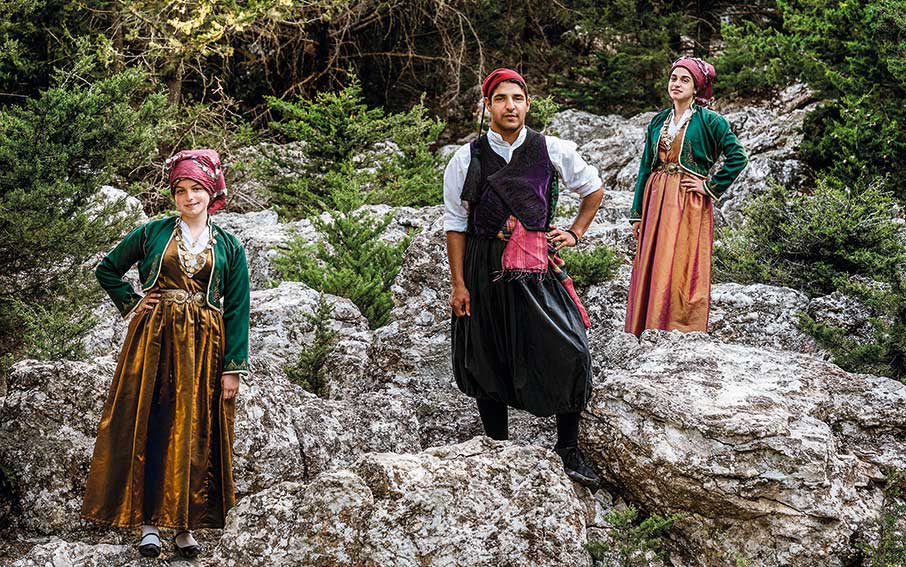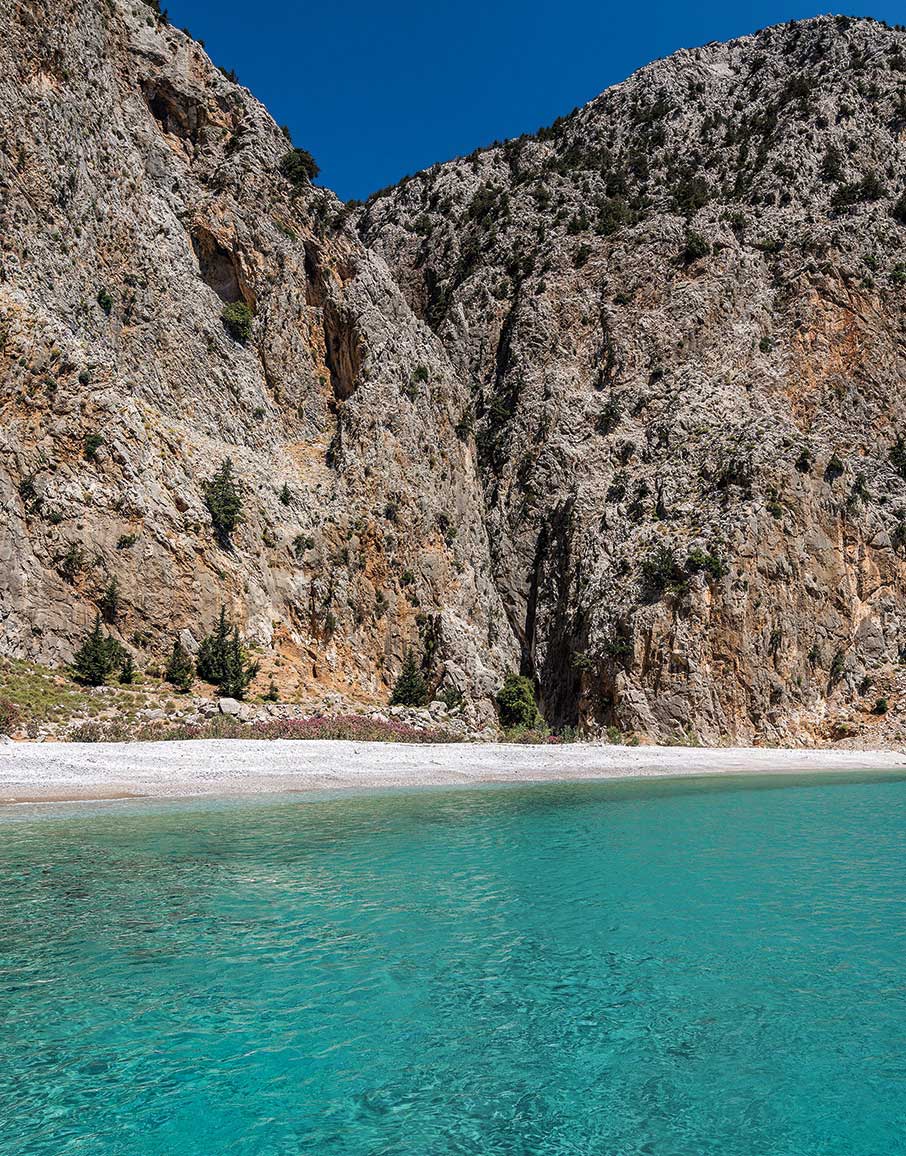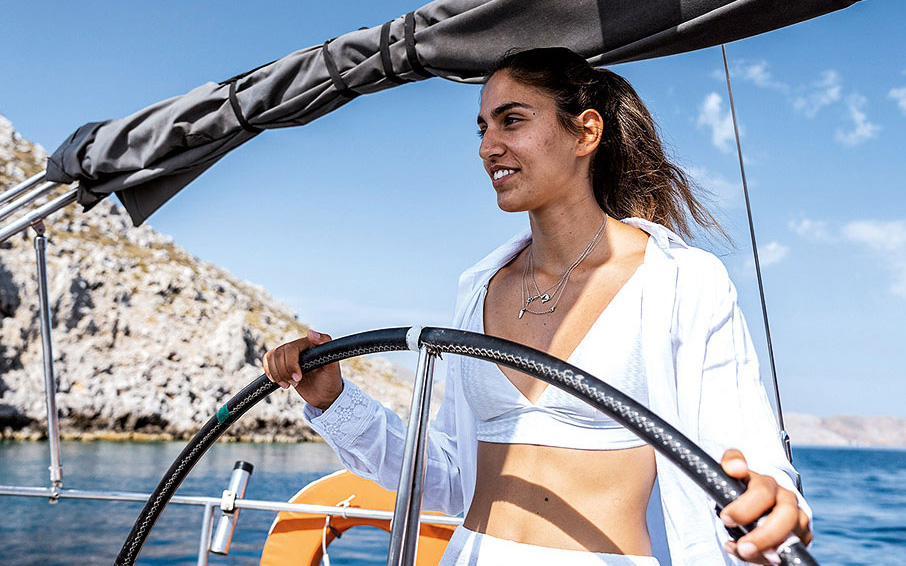She speaks first. “I’m called Melissa. My name is Greek.” He says: “I’m Neil. My name is the same as the first person to walk on the moon!”
I’m talking to Melissa and Neil, two English retirees on Symi, an island they clearly love.
They’re not the only ones. Dozens of couples from northern Europe adore this small Dodecanese island – in fact, many have bought property and live here, either for half the year or all year round. That’s high praise indeed for Symi.

© Nicholas Mastoras
All these people belong to the baby boomer generation. They grew up as the world was prospering, they worked hard, traveled, and earned money. And now, in the third phase of their life, when they are wiser and perhaps freer, when they could be anywhere they want doing anything they wish, they choose to leave their homelands, their relatives and sometimes even their grown children to settle on an island in the Aegean where access depends on the weather conditions, where there’s one main road and where the island’s permanent residents add up to no more than the population of a small neighborhood back home.
People from Britain, France and Scandinavia flock to Symi en masse to enjoy a lifestyle that their countries cannot offer them: pebbled beaches with warm waters where goats graze on samphire, and dirt roads where tortoises cross at their own pace. Symi seems to have no connection to their native lands, but there is a link, and strangely enough, it’s neoclassical architecture, an architectural style based on Greek and Roman history but brought to this island from colder climes.

© Nicholas Mastoras
The neoclassical structures of Symi came about because of the travels of Symiot sea sponge merchants throughout Europe in the late 19th century. A hundred years later, these houses, an expression of wealth and worldliness, still stand, either in renovated splendor or in need of help, depending on the financial status of each owner.
A walk from Gialos to Horio (the two main villages connected via Kali Strata, an enormous staircase with hundreds of steps) takes you past scores of wonderful multicolored neoclassical houses in different shades of ochre or maroon and blue, with the characteristic neoclassical pediments that are essential elements of Symiot architecture. With impressive originality, the Symiots have created pediments everywhere, from church bell towers to gateways; imagine an exterior door with a triple pediment – a central one with two smaller ones underneath, carved into the wooden door.
This wealth of neoclassicism, with a hint of Symiot spirit, coexists with traditional elements such as pebble mosaic flooring, stone arches and white-washed squares with enormous plane trees. What’s more, it’s traditional Greek music that floats out over the steps from the open windows of these houses.

© Nicholas Mastoras

© Nicholas Mastoras
Gastronomy and nature
As you walk around town, older residents may greet you and offer you ammoniakena (cookies made with baker’s ammonia and lemon juice) and zaharenia (cookies with powdered sugar).These unexpected encounters can be very educational, and visitors can pick up handy information on local cuisine, which goes far beyond the famed Symi shrimp (even though they’re caught in seas off various islands of the Dodecanese, these small creatures are known everywhere as “Symi” shrimp).
If someone truly wishes to explore the cooking of Symi, it’s worthwhile tracking down the book “Like Two Peas in a Pansy Pod” by two Symiots, Emmanuel K. Moraris and Dikea Maravelia, which presents traditional recipes through a contemporary lens. Flipping through its pages, readers can learn about local dishes such as palamidosoupa (bonito fish soup), achtapomakarounada (octopus spaghetti), fava xerotiganisi (yellow split peas with gently fried onions), and krommidenia giaprakia (stuffed vine leaves with onions). There’s also a recipe for Paermiotis’ baby goat.

© Nicholas Mastoras
Each recipe is accompanied by “Grandma’s tip,” a piece of advice on cooking techniques, and some nutritional information. For instance, to return to the famed Symi shrimp, the book’s authors recommend frying them until the shrimp acquire a deep orange color and to finish by dressing them with lemon juice, freshly squeezed. For this recipe, “Grandma’s tip” is to add garlic and green bell peppers for a more intense flavor.
The highlight of this useful edition, which shares with readers the gastronomic wealth of Symi, is a glossary of Symiot cooking terminology: livgoume means “spread,” gdi is the local term for a mortar and pestle, patelines are limpets and argania is oregano.

© Nicholas Mastoras
Another aspect of Symi that deserves exploration is its nature. As you walk along Gialos, you may be fooled into thinking that Symi is a dry, barren island filled with neoclassical buildings and a few scattered trees. But this is only partially true, as inland there is a large, dense cedar forest made up of self-seeded trees. Take a walk through this verdant green landscape and experience a less urban Symi, with unspoiled nature and clean air, where the silence is interrupted only by bleating of goats and the sound of their bells.
This side of Symi offers a welcome change from the inhabited areas of the island, for while the neoclassical buildings are indeed beautiful, the town can be too much at times, especially in the summer when the heat is intense, there are tourists everywhere, and there’s too much noise from cars and mopeds rolling by.


© Nicholas Mastoras
It’s towards this great forest that we are heading on a Friday afternoon. We drive towards Panagia Hames and then, once we pass not the first but the second road sign indicating “Monastery of Sotiris Mikros,” we park the car on a small flat area and take the footpath. It’s a comfortable 20-minute walk of easy to medium difficulty, flanked by trees growing from rock crevices. You really cannot escape the rocks here; they coexist in perfect harmony with the verdant forest, as stone complements cedar, and vice versa.
The bucolic Monastery of Sotiris Mikros welcomes us: flanked by two stone walls, the courtyard is filled with yellow dry grass in which sit two turkeys. There’s not a soul to be seen. At Gialos port, there was noise and cars everywhere; at Sotiris Mikros, we have the forest to ourselves.

© Nicholas Mastoras
Skirting the shore
We’ve seen much on this trip; multicolored neoclassical mansions, a verdant green cedar forest sprouting from fields of rock, and some intriguing examples of traditional cuisine. But we’ve yet to see any beaches, and our ideal guide for that is – who else? – “Poseidon,” the traditional 17-metre wooden yacht owned by Giannis Giannikos, who’s been operating the vessel for the last 28 years.
The boat “Poseidon” goes around the island every day, stopping at many beaches along the way: Aghios Emilianos, Aghios Vasilis, Fokospilia, Seskli Islet and Aghios Georgios Dysalonas. We’re unlucky on the weather front as heavy north-westerly winds prevent us from approaching the beaches on the west coast, leaving us just the eastern and southern parts of the island.
First stop is Aghios Georgios Dysalonas, the beach generally thought to be the most beautiful on the island, with its steep cliff faces. We don’t reach the shore; instead, the boat slows down and then, one after another, Scandinavian, French and British tourists jump into the sea.
Next stop is Seskli Islet. Again, the sea fills with tourists and we all enjoy an amazing swim before heading ashore for a feast under the wild olive trees; there’s Greek salad, potato salad, fasolakia (Greek green braised beans), beetroot, curry rice, pasta and gigantes (oven baked broad beans) with regato cheese. “Because many people are vegetarians, we avoid too much meat,” says the captain as we sit on benches in the shade of the trees, much like children at summer camp.
There are happy faces all around us; the foreign tourists, enchanted by the beauty of Symi, and the Greek crew members who’ve chosen to stay here rather than relocating to their larger, and even more touristic neighbor Rhodes. How come? Because they love Symi. In fact, it seems that everyone at this table, whether Symiot by blood or by choice, is happy to come back again and again for more.

© Nicholas Mastoras
New life for a historical neoclassical building
the name Fotis Mastoridis will never be forgotten in Symi, as he brought the first autonomous diving suit (“scafandro” in Greek) to the island in 1860, giving rise to sponge fishing and economic growth. At the end of the 19th century, Mastoridis built a single neoclassical mansion on Gialos; last year, that building began a new chapter in its life when it became home to the 1900 Hotel.
Architect Dimitris Zografos and civil engineer Kostas Rizopoulos were in charge of restoring the two-story mansion to its former glory. When they scraped the walls, they found dark colors such as deep ochre, dark green and dark grey. They decided to follow a similar color scheme, continuing the dark shades of the ceilings down to the walls.
Ornate ceiling paintings (the main suite boasts four cupids, the dining room a bowl of fruit) were preserved, even as the number of rooms changed; eight have become four to provide extra space for the guests.
If the larger rooms don’t make visitors feel more at home, then perhaps the business model will. The hotel operates without reception personnel or keys; instead, there are passcodes and what’s known as “honesty” bars, where visitors can serve themselves (tea, coffee, drinks) and then be charged for whatever they claim they consumed without anybody checking. In other words, it’s based on the same bonds of trust that make a house a home. (1900hotel.com) •
Info
1900 Hotel opened its doors in mid-June. For more information visit 1900hotel.com.











